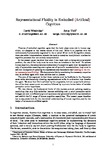Representational fluidity in embodied (artificial) cognition
| dc.contributor.author | Windridge, D | |
| dc.contributor.author | Thill, Serge | |
| dc.date.accessioned | 2018-08-16T09:50:11Z | |
| dc.date.issued | 2018-10 | |
| dc.identifier.issn | 0303-2647 | |
| dc.identifier.issn | 1872-8324 | |
| dc.identifier.uri | http://hdl.handle.net/10026.1/12160 | |
| dc.description.abstract |
Theories of embodied cognition agree that the body plays some role in human cognition, but disagree on the precise nature of this role. While it is (together with the environment) fundamentally engrained in the so-called 4E (or multi-E) cognition stance, there also exists interpretations wherein the body is merely an input/output interface for cognitive processes that are entirely computational. In the present paper, we show that even if one takes such a strong computationalist position, the role of the body must be more than an interface to the world. To achieve human cognition, the computational mechanisms of a cognitive agent must be capable not only of appropriate reasoning over a given set of symbolic representations; they must in addition be capable of updating the representational framework itself (leading to the titular representational fluidity). We demonstrate this by considering the necessary properties that an artificial agent with these abilities need to possess. The core of the argument is that these updates must be falsifiable in the Popperian sense while simultaneously directing representational shifts in a direction that benefits the agent. We show that this is achieved by the progressive, bottom-up symbolic abstraction of low-level sensorimotor connections followed by top-down instantiation of testable perception-action hypotheses. We then discuss the fundamental limits of this representational updating capacity, concluding that only fully embodied learners exhibiting such a priori perception-action linkages are able to sufficiently ground spontaneously-generated symbolic representations and exhibit the full range of human cognitive capabilities. The present paper therefore has consequences both for the theoretical understanding of human cognition, and for the design of autonomous artificial agents. | |
| dc.format.extent | 9-17 | |
| dc.format.medium | Print-Electronic | |
| dc.language | en | |
| dc.language.iso | en | |
| dc.publisher | Elsevier | |
| dc.subject | Computationalism | |
| dc.subject | Embodied cognition | |
| dc.subject | Representational frameworks | |
| dc.subject | Representational updating | |
| dc.subject | Artificial Intelligence | |
| dc.subject | Cognition | |
| dc.subject | Computational Biology | |
| dc.subject | Emotions | |
| dc.subject | Humans | |
| dc.subject | Models, Theoretical | |
| dc.subject | Sensorimotor Cortex | |
| dc.subject | Thinking | |
| dc.title | Representational fluidity in embodied (artificial) cognition | |
| dc.type | journal-article | |
| dc.type | Journal Article | |
| plymouth.author-url | https://www.ncbi.nlm.nih.gov/pubmed/30092339 | |
| plymouth.volume | 172 | |
| plymouth.publication-status | Published | |
| plymouth.journal | BioSystems | |
| dc.identifier.doi | 10.1016/j.biosystems.2018.07.007 | |
| plymouth.organisational-group | /Plymouth | |
| plymouth.organisational-group | /Plymouth/Faculty of Science and Engineering | |
| plymouth.organisational-group | /Plymouth/REF 2021 Researchers by UoA | |
| plymouth.organisational-group | /Plymouth/REF 2021 Researchers by UoA/UoA11 Computer Science and Informatics | |
| dc.publisher.place | Ireland | |
| dcterms.dateAccepted | 2018-07-19 | |
| dc.rights.embargodate | 2019-8-7 | |
| dc.identifier.eissn | 1872-8324 | |
| dc.rights.embargoperiod | Not known | |
| rioxxterms.versionofrecord | 10.1016/j.biosystems.2018.07.007 | |
| rioxxterms.licenseref.uri | http://www.rioxx.net/licenses/all-rights-reserved | |
| rioxxterms.licenseref.startdate | 2018-10 | |
| rioxxterms.type | Journal Article/Review |


